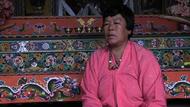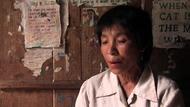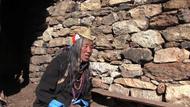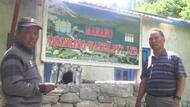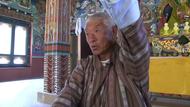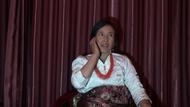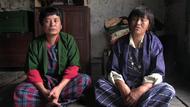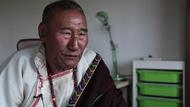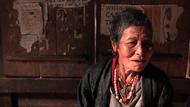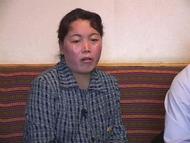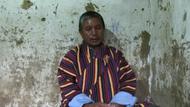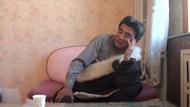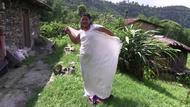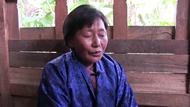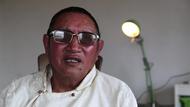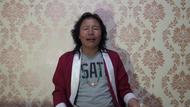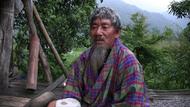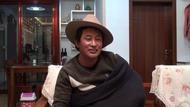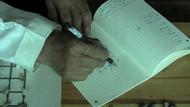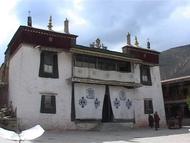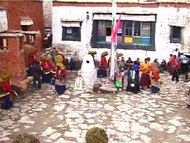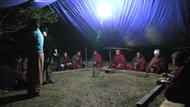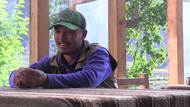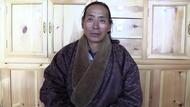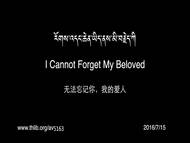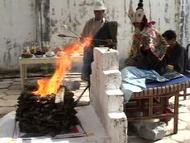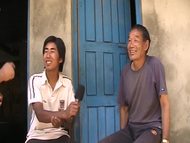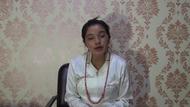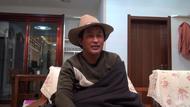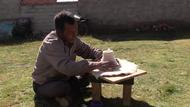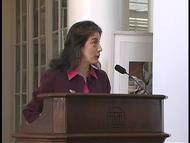Video Overview
Kelzang Lodrö gives a tour of Drotsang Dorjé Chang Monastery touching on its history
- Drotsang Gön
- ང་ཚོ་ཡོད་ས་འདི་གྲོ་ཚང་རྡོ་རྗེ་འཆང་དགོན་པ་རེད།Where we are now is Drotsang Dorjé Chang Monastery.
- དགོན་པའི་སྒོ་ནང་དུ་ཐོན་མ་ཐག་གཡས་གཡོན་གཉིས་སུ་རྡོ་རིང་གཉིས་ཡོད་ཀིAs we enter the monastery gate, there are two stelai on either side.
- རྡོ་རིང་འདི་གཉིས་ནི་ཆིང་རྒྱལ་རབས་དང་མིང་རྒྱལ་སྐབས་སུ་བཞེངས་པ་རེད།These two stelai were built during the Qing and Ming Dynasties.
- དེ་ནས་དགོན་པའི་ནང་དུ་ཅུང་ཙམ་ཡོང་ཚེ་ཡང་རྡོ་རིང་གཉིས་ཡོད་ཀིFrom here, if we walk forward a little in the monastery there are another two stelai.
- རྡོ་རིང་འདི་གཉིས་ཀྱང་ཆིང་རྒྱལ་རབས་དང་མིང་རྒྱལ་རབས་སྐབས་སུ་བཞེངས་པ་རེད།These stelai were also built during Qing and Ming dynasties.
- དེའི་ཡར་ནང་དུའང་རྡོ་རིང་ཞིག་ཡོད་པ་རེད།འོན་ཀྱང་རྡོ་རིང་དེ་ཁང་པ་ཞིག་གི་ནང་དུ་བཞག་ཡོད་པས།There is another stele on the upper side, but that monument is inside a house and
- ད་སྐབས་ང་ཚོས་མཐོང་མི་ཐུབ་ཀིWe can’t see it now.
- ད་སྐབས་དགོན་པ་འདིར་བཞུགས་པའི་བླ་མ་ཨ་ལགས་བྲག་ཚང་རེད།The current lama of this monastery is Alak Drak.
- ཁོང་ཚང་རྗེ་གླང་དཀར་བ་ཚང་གི་སྤྲུལ་རེད།He is the reincarnation of Jé Lang Karwa
- ད་སྐབས་དགོན་པ་འདིར་བཞུགས་པའི་གྲྭ་བ་བཅུ་ལྷག་མ་གཏོགས་མེད་ཀིThere are only around ten monks in this monastery now.
- དགོན་པ་འདི་བཞེངས་མཁན་ནི་The founder of this monastery is called
- གྲུབ་ཆེན་མཚོ་རྙིང་བའམ་གླིང་དཀར་བ། བླ་མ་བསམ་བློ་བ་ཟེར་བ་དེ་རེད།Drupchen Tsonyingwa or Ling Karwa--Lama Samlowa.
- ཁོང་ཚང་གིས་སྔོན་ཆད་མཚོ་རྙིང་ནས་མཚམས་ལ་ཡུན་རིང་བཞུགས་ཏེ་སྒྲུབ་སྦྱོང་བྱས་པ་རེད།Before he meditated for a long time at Tsonying and studied.
- ཕྱིས་སུསྤྱི་ལོ ༡༣༨༩ ལོར་ཀྲུའུ་ཡོན་ཀྲང་གིས་ཁོང་ཚང་རྒྱལ་སར་གདེན་འདྲེན་བྱས་པ་རེད།Later in 1389, Zhu Yuan Zhang invited him to the capital.
- སྤྱི་ལོ ༡༣༩༢ ལོར་དགོན་པ་འདི་བཞེངས་པ་རེད།In 1392 this monastery was built.
- ཨ་ཁུས་བཤད་པ་ལྟར་ན།According to you
- བླ་མ་བསམ་བློ་བས་ཀྲུའུ་ཡོན་ཀྲང་ལ་དགོན་པ་འདིའི་འདྲ་ཞིག་བཞེངས་འདོད་ཡོད་པ་བཤད་པ་རེད།Lama Samlowa told Zhu Yuan Zhang he hoped to erect a likeness of this monastery.
- སྐབས་དེར་ཀྲུའུ་ཡོན་ཀྲང་རྒྱལ་པོ་བསྡད་མ་ཐག་ཡིན་པས།That time was just after Zhu Yuan Zhang became the emperor
- མ་དངུལ་གྱི་རོགས་རམ་ཆེན་པོ་བྱེད་མ་ཐུབ་པ་རེད།So he couldn’t provide financial help.
- ཁོངའདྲི་ཡོང་ནས་འདུར་ཁང་གཅིག་བཞེངས་པ་རེད།ང་ཚོ་ཡར་སོང་ན་ཐོག་དང་པོར་འཕྲད་པའི་འདུག་ཁང་དེ་རེད།He came here and built an assembly hall; if we go up we will see it first.
- འདུ་ཁང་བཞེངས་རྗེས་ཕྱིར་སོང་ནས་རྒྱལ་པོ་ལ་ཞུས་པས།After he built the assembly hall he went back and told the emperor.
- རྒྱལ་པོས་དགོན་པའི་མིང་ལ་༼ཆུ་ཏན་འཚ་༽བཏགས་པ་རེད།The emperor gave the name "Qu Tan Temple" to the monastery. 国王给了瞿坛寺的名寺院。
- ༼ཆུ་ཏན་འཚ་༽ཟེར་དོན་ནི་སྟོན་པ་སངས་རྒྱས་ཀྱི་མིང་༼ཅིའུ་འད་མོ་ཆི་འད་འདོ་༽The reason why it is called "Qu Tan Temple" is because of Buddha’s name Qiao Da Mo Xi Da Duo 它之所以被称为瞿坛是因为佛的名字乔达摩悉达多
- ༼ཅིའུ་འད་མོ་༽ཟེར་བ་དེ་རྒྱ་ལ་གྱུར་ནས་༼ཆུ་ཏན་འཚ་༽ཞེས་གྲགས་པ་རེད།乔达摩 Qiao Da Mo later became Chinese as Qu Tan Monastery 乔达摩后来成为中国名字瞿坛寺
- དགོན་པའི་མིང་དེ་ལྟ་འདོགས་དོན་ཡང་ནང་གི་གཙོ་སྐུ་སྟོན་པ་ཤཱཀྱ་ཐུབ་པ་དང་དུས་གསུམ་སངས་རྒྱས་རེད།The reason why the monastery is called this is also because of its main statues, which are of Shakyamuni Buddha and the buddhas of the three times.
- གཡས་གཡོན་ན་ཁང་བ་གྱན་སུམ་བཅུ་སོ་དྲུག་རེ་བསྡོམས་པས་གྱན་བདུན་བཅུ་དོན་གཉིས་ཡོད་ཀིThere are thirty-six rooms on both sides and there are seventy-two rooms total.
- དཀྱིལ་གྱི་ལྷ་ཁང་གསུམ་པོ་ཡང་བསྣན་ན་བསྡོམས་པའི་བདུན་བཅུ་དོན་ལྔ་ཡོད་ཀིThere are a total of seventy-five rooms including the three temples at the center.
- ༡༩༨༥ལོར་རྒྱལ་སྲིད་སྤྱི་ཁྱབ་ཁང་གིས་In 1985 the government
- རིག་དངོས་་སྲུང་སྐྱོབ་བྱེད་པའི་སྡེ་ཁག་ཏུ་གཏན་འཁེལ་བྱས་པ་རེད།Declared it a cultural preservation section
- ང་ཚོའི་ཁ་དཔེ་ལ་རྡོ་རྗེ་འཆང་གི་ཅོང་རྡུང་ན། བ་ཡན་ཐང་གི་རངྟ་འདྲོག་ཟེར་བའི་As there is a saying that when you ring the bell of Dorjé Chang, RangTa of Ba Yan Thang startles.
- རྡོ་རྗེ་འཆང་གི་ཅོང་དེ་ཡང་ད་ལྟ་འདི་ན་བཞུགས་ཀིThe bell of Dorjé Chang is also located here.
- ཅོང་དེ་ལྔ་བརྒྱད་ལོ་ཆག་སྐྱོན་བྱུང་ནས་གས་ཆག་ཅུང་ཟད་ཤོར་ཡོད་པ་རེད།That bell was slightly broken in 1958.
- ཕྱིས་སུ་ལྕགས་ཀྱི་ལྷན་པ་བརྒྱབ་ནས་ཞིག་གསོ་བྱས་ཡོད་དགོན་པ་འདིར་བཞུགས་ཀིLater it was repaired with metal and it is in this monastery now.
- འོན་ཀྱང་ཅོང་དེ་ཉིས་ཐོག་ཏུ་ཡོད་པ་དང་ཐེམ་སྐས་ཤིང་གིས་ལས་པ་ཡིན་པས།But that bell is on the second floor and the stairs are made of wood.
- སྣོད་སྐྱོན་བྱུང་བྲ་དོགས་ཏེ་ལྟ་སྐོར་དུ་འགྲོ་རུ་མི་འཇུག་པ་རེད།They are afraid the stairs will break, so it is not possible to see it.
- དེའི་ཡར་ནང་དུ་སོང་ན་ཇོ་ཁང་རེད།On the upper side there is the Jokhang
- ཇོ་ཁང་ནང་གི་གཙོ་སྐུ་ཇོ་བོའི་སྐུ་རེད།The main statue in the Jokhang is the statue of Jowo .
- ཇོ་སྐུའི་གཡས་གཡོན་དུ་རྗེ་རིན་པོ་ཆེ་དང་བླ་མ་བསམ་བློ་བའི་སྐུ་འདྲ་གཉིས་ཡོད་པ་རེད།On the left and right of the Jowo statue are the images of Jé Rinpoché and Lama Samlowa.
- འདི་བཞེངས་མཁན་ནི་ཀྲུའུ་ཡོན་ཀྲང་གི་བུ་ཡིན་ཟེར་ཀིIt is said that the founder is Zhu Yuan Zhang’s son.
- དེའི་ཡར་ནང་དུ་ཀྲུའུ་ཡོན་ཀྲང་གི་ཚ་བོས་༼ཏ་ཧཨེ་འདིན་༽དཔེར་ལྟོས་ཏེ་ལྷ་ཁང་ཞིག་བཞེངས་པ་རེད།On the upper side, Tai He Dian as an example, Zhu Yuan Zhang’s grandson built a temple
- དེའི་ནང་གི་གཙོ་སྐུ་རྡོ་རྗེ་འཆང་གི་སྐུ་རེད།The main statue is the statue of Dorjé Chang.
- སྐུ་འདྲ་མ་གཏོགས་ད་དུང་རྔ་ཞིག་ཡོད་ཀིBesides the image, there is also a drum.
- གྱང་ངོས་ཀྱི་ལྡེབས་རིས་དང་སྐུའི་འོག་གི་སྟེགས་བུ་ཚང་མ་མ་འཇིག་པར་སྔོན་ཆད་ཀྱི་དེ་ལྟར་ཡོད་ཀིThe painting on the wall and the stage under the statue were not destroyed and remain as before.
- དགོན་པའི་མཐའ་སྐོར་གྱི་ཕྱི་ཡི་བཀོད་པ་ཡང་སྔོན་ཆད་ཀྱི་དེ་མ་འཇིག་པར་ཡོད་པ་རེད།The outside view of the monastery is also untouched and remains as before.
- ཅོང་ཆེན་པོ་གཉིས་དང་ཆུང་ཆུང་ལྔ་ཡོད་ཀིThere are two big bells and five small bells.
- ད་དུཁྱད་པར་མ་ཡིན་པའི་རྔ་ཡང་ཆེན་པོ་ཞིག་ཡོད་ཀིAnd also there is a very big non-special drum.
- རྔ་དེ་ནི་རྡོ་ཡི་གླིང་བོ་ཆེ་ཞིག་གི་རྒྱབ་ཏུ་ཁུར་ཡོད་པ་ཞིག་རེད།That drum is carried on the back of a big stone elephant.
- རྔ་འདི་ལོ་ངོ་མང་པོའི་ལོ་རྒྱུས་ཡོད་པར་མ་ཟད།རྒྱལ་ནང་དུ་འདི་གཅིག་པུ་ལས་མེད་པ་རེད་ཟེར།This drum is very old and it is said that it is the only one like it in China.
- རྔ་ཆེ་བ་གཉིས་དང་ཆུང་བ་ལྔ་སཡོད་པ་རེད།There are two big drums and five small drums.
- བླ་མ་གླིང་དཀར་བས་དགོན་པ་འདི་བཏབ་རྗེས་After Lama Lingkarwa established this monastery
- ཁོང་ཚང་གི་ཁྱིམ་རྒྱུད་འདིར་གནས་སྤར་བ་རེད།His family moved to this place.
- ཁོང་ཚང་གནས་འདིར་གཞིས་ཆགས་ཏེ་ས་ཆ་འདིས་དཔོན་པོ་བྱས་པ་རེད།His family located here and became the leaders of this area.
- ཁོང་ཚང་གྲོ་ཚང་ནས་ཡོང་བའི་རྐྱེན་གྱིས་ས་ཆ་འདིའི་མིང་ལའང་གྲོ་ཚང་ཞེས་ཐོགས་པ་རེད།Because his family came from Drotsang, this place is also named Drotsang.
- རྗེས་སུ་ལུ་ཏུའུཡི་ལྷོ་ཕྱོགས་ཀྱི་ལུང་བ་འདིའི་མིང་ལ་གྲོ་ཚང་ཞེས་པའི་མིང་ཐོགས་པ་རེད།Later the south valley of Lu Tu’u is also called Drotsang.
- འདི་ནི་སྒོ་ཡི་ནང་ཕྱོགས་སུ་ཡོད་པའི་རྡོ་གཅལ་རེད།This is the stone floor inside the door.
- རྡོ་ཅལ་འདི་ལོ་ངོ་ལྔ་བརྒྱ་ནས་དྲུག་བརྒྱ་འགོར་ཡོད།གThis stone floor is 500-600 years old.
- རྡོ་ཅལ་འདིའི་སྟེང་དུ་སྐབས་དེའི་མི་རྣམས་ཀྱི་རྐང་རྗེན་ཕབ་ཡོད་པ་རེད།There are footprints on this stone floor
- རྐང་རྗེ་འདི་དག་ལ་ལྟས་ན་ལོ་དྲུག་བརྒྱ་སྔོན་གྱི་མི་དེ་དག་གི་གཟུགས་པའི་རིང་ཚད་ལ་According to these footprints, the height of people six hundred years ago
- རྨིད་གཉིས་ཙམ་ལེ་ཡོད་འདོད་པའི་ཚོར་སྣང་ཡོད་པ་རེད།Feels like around two meters
- ད་སྐབས་སྒོ་འདི་དགོན་པའི་མདུན་སྒོ་རེད།Now this door is the front door of this monastery.
- སྔོན་ཆད་སྒོ་འདིའི་མར་ནང་དུ་ད་དུང་སྒོ་ལྔ་ཡོད་ཟེར་བ་རེད།Before there were five doors down here
- ད་སྐབས་སྒོ་འདི་མ་གཏོགས་མེད་པ་རེད།Now there is only this door.
- སྔོན་ཆད་སྒོ་ལྔ་བོ་དྲང་ཐིག་གཅིག་གི་སྟེང་དུ་བབས་ཏེ་རྡོ་རྗེ་འཆང་གི་ལྷ་ཁང་གི་In the past, those five doors were standing in one line and the temples of Dorjé Chang
- མདུན་དུ་སླེབས་ཡོད་པ་སོགས་བཀོད་པ་ཐུན་མོང་མ་ཡིན་པ་ཞིག་ཡིན་ཟེར།were located in front and it was very different.
 Loading ...
Loading ... 